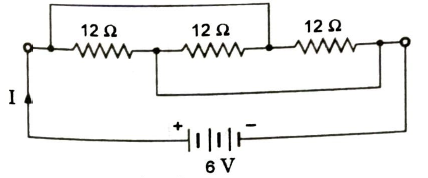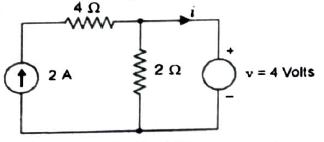Electrical Circuit Analysis MCQ
Electrical Circuit Analysis MCQ, Multiple Choice Questions on Electrical Circuit Analysis, Objective Type Questions on Electrical Circuit Analysis MCQ, MCQ on KCL, MCQ on KVL, Kirchoff’s Current Law MCQ, Kirchoff’s Voltage Law MCQ, Engineering MCQ, MCQ on Basic Electrical Engineering
Multiple Choice Questions
Q.1. Ideal voltage source should have:
- zero internal resistance
- infinite internal resistance
- large value of EMF
- low value of current
Answer: zero internal resistance
Q.2. Ideal voltage sources have:
- zero internal resistance
- infinite internal resistance
- large value of EMF
- low value of current
Answer: zero internal resistance
Q.3. Ideal current sources have:
- zero internal resistance
- infinite internal resistance
- low value of voltage
- large value of current
Answer: infinite internal resistance
Q.4. A dependent source:
- may be a current source or a voltage source
- is always a voltage source
- is always a current source
- neither a current source nor a voltage source
Answer: maybe a current source or a voltage source
Q.5. Three resistances each of R Ω are connected to form a triangle. The resistance between any two terminals will be:
- RΩ
- 3/2 RΩ
- 3 RΩ
- 2/3 RΩ
Answer: 2/3 RΩ
Q.6. For the circuit shown below the equivalent resistance will be

- 36 Ω
- 12 Ω
- 4 Ω
- 6 Ω
Answer: 6 Ω
Q.7. For the circuit shown for Q.6, the current flowing through the circuit will be
- 1:5 A
- 1.0 A
- 0.5 A
- 0.75 A
Answer: 1.0 A
Q.8. How are 500 Ω resistors connected so as to give an effective resistance of 750 Ω?
- Three resistors of 500 Ω each, in parallel
- Three resistors of 500 Ω each, in series
- Two resistors of 500 Ω each, in parallel
- Two resistors of 500 Ω each, in parallel and the combination in series with another 500 Ω resistor
Answer: Two resistors of 500 Ω each, in parallel and the combination in series with another 500 Ω resistor
Q.9. For the circuit shown below the resistance between points A and C is

- 200 Ω
- 250 Ω
- 550 Ω
- 750 Ω
Answer: 250 Ω
Q.10. Which of the following is an active element in a circuit?
- Current source
- Resistance
- Inductance
- Capacitance
Answer: Current source
Q.11. A terminal where more than two branches meet is known as
- node
- terminus
- anode
- none of these
Answer: node
Q.12. Kirchhoff’s voltage law is concerned with:
- IR drop
- battery emfs
- junction voltage
- both IR drop and battery emfs
Answer: both IR drop and battery EMFs
Q.13. According to Kirchhoff s voltage law, the algebraic sum of all IR drops and EMFs in any closed loop of a network is always
- negative
- positive
- zero
- determined by emfs of the batteries
Answer: zero
Q.14. The algebraic sign of an IR drop primarily depends upon the
- direction of flow of current
- battery connections
- magnitude of current flowing through it
- value of resistance
Answer: direction of flow of current
Q.15. The superposition theorem requires as many circuits to be solved as there are
- nodes
- sources
- nodes and sources
- meshes
- nodes, sources and meshes
Answer: sources
Q.16. Maxwell’s loop current method of solving electrical networks:
- uses branch currents
- utilizes Kirchhoff’s voltage law
- is confined to single-loop circuits
- is a network reduction method
Answer: utilizes Kirchhoff’s voltage law
Q.17. Mesh analysis is based on:
- KVL
- KCL
- both
- law of conservation of energy
Answer: KVL
Q.18. Nodal analysis is based on:
- KCL
- KVL
- both
- law of conservation of energy
Answer: KCL
Q.19. In nodal analysis, if there are N nodes in the circuit, then how many equations will be written to solve the network?
- N – 1
- N + 1
- N
- N – 2
Answer: N – 1
Q.20. In nodal analysis, if there are N nodes in the circuit, then how many equations will be written to solve the network?
- (N – 1)
- N
- (N + 1)
- (N – 2)
Answer: (N – 1)
Q.21. An electrical network with six independent nodes has:
- 10 loop equations
- 3 loop equations
- 5 loop equations
- 7 loop equations
Answer: 5 loop equations
Q.22. Point out the wrong statement.
In the node voltage technique of solving networks, the choice of a reference node does not:
- affect the operation of the circuit
- change the voltage across any element
- alter the pd between any pair of nodes
- affect the voltages of various nodes
Answer: affect the voltages of various nodes
Q.23. While Thevenizing a circuit between two terminals, VTH is equal to
- short-circuit terminal voltage
- open-circuit terminal voltage
- net voltage available in the circuit
- emf of the battery nearest to the terminals
Answer: open-circuit terminal voltage
Q.24. Thevenin’s resistance RTH is determined
- by short-circuiting the given two terminals
- by removing the voltage sources along with their internal resistances
- between same open terminals as for VTH
- between any two open terminals
Answer: between same open terminals as for VTH
Q.25. While determining RTH of a circuit
- voltage and current sources should be left as they are
- all sources should be replaced by their source resistances
- all independent current and voltage sources are short-circuited
- none of the above
Answer: all sources should be replaced by their source resistances
Q.26. Which of the following statements is/are correct
- Norton’s equivalent resistance is the same as Thevenin’s equivalent resistance RTH
- Norton’s equivalent is the current equivalent of the network
- The load is connected in parallel to the Norton’s equivalent resistance and Norton’s equivalent current source
- all of the above
Answer: all of the above
Q.27. While determining RTH in Thevenin’s and Norton’s equivalent
- only current sources are made dead
- only voltage sources are made dead
- all independent sources are made dead
- all current and voltage sources are made dead
Answer: all independent sources are made dead
Q.28. In the circuit shown in the figure, the voltage across the 2 Ω resistor is

- 6 V
- 4 V
- 2 V
- zero
Answer: 2 V
Q.29. When the power transferred to the load is maximum, the efficiency of power transfer is:
- 25%
- 50%
- 75%
- 100%
Answer: 75%
Q.30. In the circuit shown in the figure, what will be the value of current i through voltage source when v = 4 V?

- 1 A
- 2 A
- 0 A
- 3 A
Answer: 0 A
Q.31. For maximum transfer of power, the internal resistance of the source should be
- equal to load resistance
- less than that of load
- more than that of load
- none of the above
Answer: equal to the load resistance
Q.32. If in the delta, RC = 2 Rb, Rb = Ra, then the star resistance in the above question will be
- Rb/2
- 2Rb
- Rc
- Rc/2
Answer: Rb/2
Q.33. A Y arrangement of resistances has each resistance of 3 Ω. The equivalent delta arrangement will have each resistance of values
- 9 Ω
- 6 Ω
- 3 Ω
- 1 Ω
Answer: 9 Ω
Q.34. Three equal resistances are connected in the star. If this star is converted into an equivalent delta
- The resistance of both the networks will be equal
- the resistances of the delta network will be smaller than those of star network
- the resistances of the delta network will be larger than those of star network
- none of the above
Answer: the resistances of the delta network will be larger than those of the star network